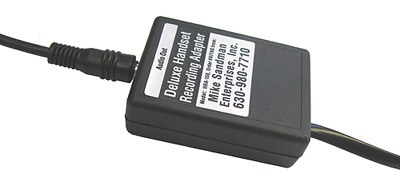What is Sidetone, and why do you need it?
Sidetone is when you hear a little bit of your own voice in your ear as you are talking on a traditional phone / handset. For most of us it makes it more comfortable to talk on the phone.
Phones have had sidetone for over a hundred years. It was originally put there at a particular volume (fairly low) so the caller would get an idea if they were talking too loudly, creating distortion on the old transmitters.
Phones universally had sidetone until smaller cell phones became popular. On those phones they removed the sidetone to prevent feedback (squeal) that you get when the mic is too close to the speaker. There is no sidetone on speakerphones.
When VoIP phones came out some manufacturers decided to remove sidetone as an easy way to prevent echo, rather than designing the telephone properly. While a phone is usable without sidetone for normal conversation, it's not much fun to use. One of the benefits of sidetone is that you know if you've been cut-off from the call. A lot of us have found ourselves talking for a while on our cell phone, only to realize that there was nobody on the other end because the call was dropped.
When key telephones and single line telephones used analog voice, businesses were able to record or monitor (called "service observing") from the analog voice pair going to the phone. Many older key telephones used an analog pair for the talk path for voice, and a second digital pair for signaling (line selection, lights, ringing and hold). A voice activated (vox) recorder connected to the analog voice pair would record all of the conversations on that phone, time stamp them, and let you search for the conversation.
When phones came out with digitized voice (as well as signaling), and then VoIP phones became popular, the only place they were analog was at the handset (since we all still have analog ears and mouths).
Actually, you can record VoIP calls by copying the VoIP voice packets (RTP packets) as they go into your router via Ethernet with a special VoIP logger. The logger assembles the packets from the conversation and saves the conversation as an audio file (like an mp3).
Many VoIP PBXs have a call recording feature built-in, and some digital phone systems like ESI have had an internal call recording function for many years.
You can play with it yourself if you put Wireshark on a laptop and setup a mirrored port on a managed Ethernet switch to monitor all the traffic on the port that's going to the router. Save all the packets to a file in Wireshark, then click on Wireshark's VoIP button and tell it to play back a call from whatever IP address you'd like. You'll hear the whole call - both sides of it. Note that this won't work if you're using a secure VoIP format that encrypts voice packets.
If that sounds complicated, there's an easier way!
For digital phone system phones as well as VoIP phones, it's often easier and cheaper to record from the only place it's analog... off the receiver wires of the handset jack.
The handset jack and a modular headset jack have some real benefits as opposed to recording from an analog station pair / POTS line. When you record from an analog pair (that works with a standard analog home phone) the local person is often recorded at a much louder level than the person at the other end. Some voice loggers have an automatic gain control that tries to fix that problem.
When you record from the handset jack (the receiver wires) on a normal phone with sidetone, the levels of both parties is about perfect. The person on the phone locally is heard at the lower sidetone volume level, and the person at the far end is recorded at normal level. It just plain works great for recording or service observation.
Keep in mind that a modular headset jack is often wired differently from a modular handset jack, mainly so you can plug a headset directly into the phone without the need for an amplifier in-front of the headset.
On business phones with a 2.5mm audio plug for the headset (used on older cell phones), there's a chance that there will be no sidetone on the headset jack. And, recording from a 2.5mm headset jack is difficult because the 2.5mm jack only has three wires, not four. With the common ground for transmit and receive there may be hum or noise if you try to record from that jack.
Most real voice loggers made for recording analog phone lines or analog stations are transformer isolated, and the inexpensive Handset Y Adapter using a spare pair to the recorder from the Handset Y Adapter will work fine.
For tape recorders, PCs and anything not made to be connected to a real phone line, you'll need to get a Deluxe Handset Recording Adapter which transformer isolates the phone from the recording device, so you don't hear hum and noise:

You need to isolate the electronic telephone (which has a reference to ground through the phone's or system's AC power) and the recording device with an isolation transformer. Otherwise, you get a ground loop or foreign voltage... and the resulting hum and noise.
There are lots of voice loggers on the market these days. If you need to record all the stations to a single logger the cost of multi-channel loggers has come down in the last few years, but they aren't cheap. When recording from the handset, you send the receiver audio down a spare pair to the phone room, and cross connect that pair into a channel on the voice logger (usually placed in the phone room).
Sometimes you need multiple people to hear a conversation in the same room or another room as someone on a handset (and you don't want to use a speakerphone because the person on the other end will be able to tell). Our Orator III one-way amplifier / speaker will plug into an analog line or station port, as well as to the handset on a digital or VoIP phone using a Handset Kit.
As long as you hear sidetone in the handset or headset jack, you'll be able to hear both sides of the conversation when recording or monitoring.
If you don't hear a little of your own voice in your ear, you don't have sidetone and when you record or monitor, you'll only get the party at the far end, not the person on the local phone.

 Products
Products